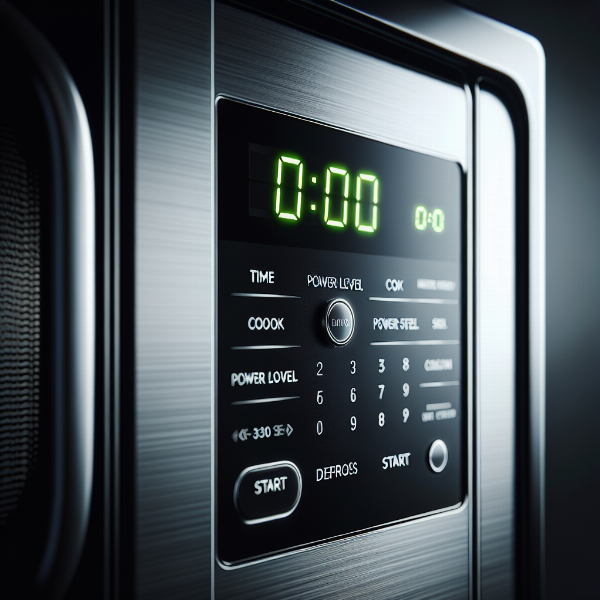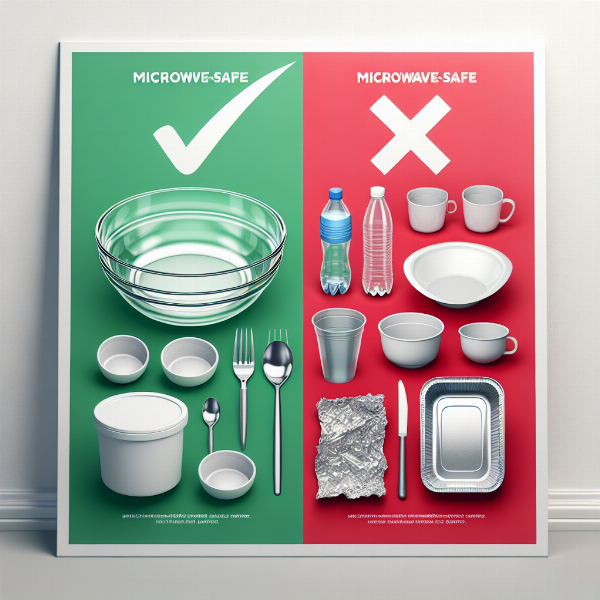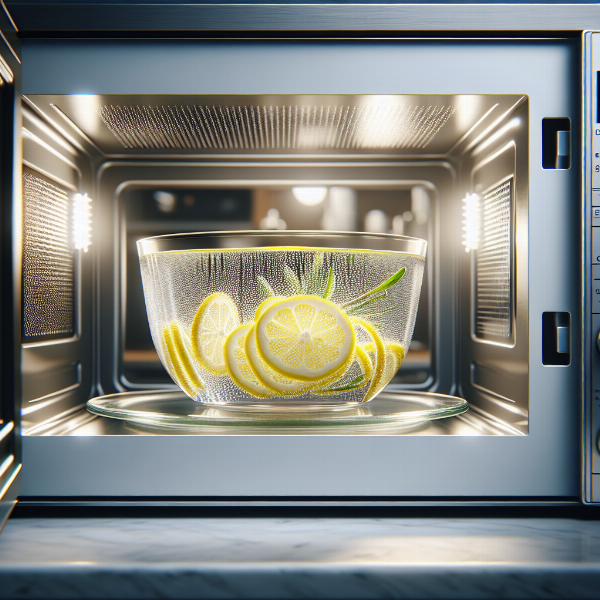Welcome to the heart of your kitchen’s convenience! So, you’ve got a brand new microwave, or perhaps you’re just looking to finally master the one that’s been sitting on your counter. Learning How To Use A Microwave Oven properly can feel like unlocking a superpower. It’s not just a box for reheating leftovers; it’s a versatile tool that can defrost, steam, and even cook entire meals in minutes. Forget the intimidation of endless buttons and cryptic symbols. In this guide, we’ll walk you through everything from the basic controls to essential safety tips, transforming you from a microwave novice to a confident kitchen pro. Let’s get cooking!
Getting Started: Your First Steps with a New Microwave
Before you can zap your first meal, a little setup is required. It’s simple, we promise.
- Find the Right Spot: Place your microwave on a flat, stable, and heat-resistant surface like a countertop. Ensure there’s enough clearance around it (check your user manual, but a few inches on all sides is a good rule of thumb) for proper ventilation. Overheating is a microwave’s worst enemy.
- Plug It In: Use a grounded outlet. Avoid using extension cords if possible, as microwaves draw a significant amount of power.
- Read the Manual: I know, I know. But a quick skim of the manual for your specific model is always a good idea. It will highlight any unique features or safety warnings you need to be aware of.
Decoding the Control Panel: What Do All Those Buttons Mean?
The control panel is your mission control. While they vary slightly between models, most microwaves share a set of core functions. Let’s break down the most common ones.
The Essentials
- Numeric Keypad (0-9): This is for setting the cooking time. Want to heat something for 1 minute and 30 seconds? Just type in
1,3,0. - Time Cook / Cook Time: This is the most fundamental button. You press this, enter the desired time using the keypad, and then hit Start.
- Power Level: This is a game-changer! Not everything needs to be cooked at 100% power (which is the default). Lowering the power level is perfect for gently melting butter, softening ice cream, or cooking delicate foods without turning them rubbery. A common scale is 1-10, where 10 is 100% power.
- Start / +30 Sec: This button does what it says—it starts the cooking process. On many models, tapping it multiple times will add 30 seconds to the cooking time, which is perfect for a quick reheat.
- Stop / Cancel: Press this once to pause the microwave (if you want to stir your food, for example). Press it twice to clear the current settings and stop the process entirely.
Common Presets & Functions
- Defrost: This crucial function uses intermittent bursts of low power to thaw frozen food without cooking the edges. Most modern microwaves offer two options:
- Time Defrost: You manually set the defrosting time.
- Weight Defrost: You enter the weight of the food, and the microwave calculates the optimal time automatically.
- Popcorn: A classic! This preset is specifically calibrated to pop a standard bag of microwave popcorn without burning it.
- Pizza / Potato / Beverage: These are other common presets that use pre-programmed time and power settings for specific food items. They’re great for convenience but may require some trial and error to get perfect results with your specific food portions.
 A close-up of a modern microwave oven control panel, highlighting the essential buttons like Power Level, Time Cook, Start, and Defrost.
A close-up of a modern microwave oven control panel, highlighting the essential buttons like Power Level, Time Cook, Start, and Defrost.
Your First Mission: How to Use a Microwave Oven for Reheating
Reheating is the microwave’s claim to fame. But there’s a right way and a wrong way to do it. Follow these steps to avoid cold centers and dried-out edges.
- Choose a Safe Container: Place your food in a microwave-safe dish. More on this later, but glass or ceramic are always excellent choices.
- Arrange Food Smartly: Spread the food out in an even layer. If you’re reheating a mix of items, like chicken and rice, place the denser, slower-heating items (the chicken) on the outer edge of the plate and the lighter items (the rice) in the middle.
- Cover It Up: Cover the dish with a microwave-safe lid, a damp paper towel, or microwave-safe plastic wrap (leaving a small vent for steam to escape). This traps moisture and prevents splatters.
- Heat and Stir: Start with a shorter time than you think you need—say, 60-90 seconds. Take it out, give it a good stir to redistribute the heat, and then heat it in 30-second intervals until it’s perfectly hot.
Expert Tip: “People often blast their leftovers on high power for three minutes and wonder why they’re rubbery,” says Chef Isabella Rossi, a culinary instructor. “The secret is to use a lower power level—around 70%—and stir halfway through. It takes an extra minute, but it ensures your food is heated evenly and retains its moisture. It’s the difference between a sad meal and a delicious one.”
Beyond Reheating: Exploring Basic Microwave Functions
Your microwave is more than a one-trick pony. Let’s explore a couple of other key uses.
Mastering the Defrost Function
Defrosting in the microwave saves hours compared to waiting for food to thaw on the counter.
- Remove Packaging: Take the frozen food out of its store packaging, especially foam trays and plastic wrap, which can melt or release chemicals.
- Use the Right Setting: If your microwave has a weight-defrost setting, use it! It’s much more accurate. If not, use a low power level (around 30%) and set a time based on the food’s weight (a general rule is 5-7 minutes per pound).
- Flip and Separate: Pause the microwave halfway through to flip the food over. If you’re defrosting ground meat or chicken pieces, try to separate them as they thaw.
- Cook Immediately: Once food is thawed in the microwave, you should cook it right away to prevent bacteria growth.
Cooking from Scratch
Yes, you can cook real food! The microwave is fantastic for steaming vegetables. Simply place chopped veggies in a microwave-safe bowl with a couple of tablespoons of water, cover, and cook on high for 3-5 minutes until tender-crisp. You can also cook a perfect baked potato in about 5-8 minutes—just remember to pierce the skin with a fork first!
The Golden Rules: Microwave Safety You Can’t Ignore
Understanding how to use a microwave oven safely is non-negotiable. Microwaves work by using electromagnetic waves to excite water molecules in food, creating heat. This process requires you to follow a few key rules to prevent accidents.
- Never run it empty: This can seriously damage the internal components of the microwave.
- Use microwave-safe cookware: Not all dishes are created equal.
- Never put metal inside: This includes aluminum foil, cutlery, and dishes with metallic trim. Metal reflects microwaves, which can cause sparks (a phenomenon called ‘arcing’) and even start a fire.
- Be careful with liquids: Water and other liquids can become superheated in a microwave without appearing to boil. When you move the container, it can erupt violently. To prevent this, place a non-metallic object like a wooden spoon or chopstick in the liquid before heating.
- Clean up spills immediately: Food splatters can absorb energy during subsequent uses, potentially causing burns or damage to the microwave’s interior.
Microwave-Safe Containers: What to Use and What to Avoid
Using the wrong container is one of the most common microwave mistakes. Here’s a quick guide.
| Material | Safe to Use? | Notes |
|---|---|---|
| Glass & Ceramic | Yes | Your safest bet. Ensure there is no metallic paint or trim. |
| Microwave-Safe Plastic | Yes (with caution) | Look for the “Microwave Safe” label. Avoid single-use containers like takeout boxes. |
| Paper Towels & Plates | Yes (for short periods) | Use for reheating or covering food to absorb splatters. Avoid printed or recycled paper. |
| Metal & Aluminum Foil | No | A major fire hazard. Do not use. |
| Styrofoam | No | Can melt and release harmful chemicals into your food. |
| Brown Paper Bags | No | Can catch fire. |
 A side-by-side comparison showing microwave-safe containers like glass bowls and ceramic plates next to unsafe items like a metal fork and a styrofoam cup.
A side-by-side comparison showing microwave-safe containers like glass bowls and ceramic plates next to unsafe items like a metal fork and a styrofoam cup.
Expert Insight: According to Dr. Kenji Tanaka, a Food Safety Specialist, “The ‘microwave-safe’ symbol is your best friend. If a plastic container doesn’t have it, don’t risk it. Chemicals from non-safe plastics can leach into your food when heated. When in doubt, always default to glass or ceramic.”
Keeping It Clean: Simple Microwave Maintenance
A clean microwave is a happy and efficient microwave. The easiest way to clean a dirty interior is with steam.
- Combine 1 cup of water and a few tablespoons of white vinegar (or the juice of half a lemon) in a microwave-safe bowl.
- Microwave on high for 3-5 minutes, until the mixture is boiling and the window is steamy.
- Let it sit with the door closed for another 5 minutes. The steam will loosen all the caked-on gunk.
- Carefully remove the hot bowl and the turntable. Wipe the inside clean with a sponge or paper towel. It should come off with zero scrubbing!
 The inside of a microwave with a glass bowl of water and lemon slices, creating steam to loosen food splatters for easy cleaning.
The inside of a microwave with a glass bowl of water and lemon slices, creating steam to loosen food splatters for easy cleaning.
Conclusion
You’ve done it! You now know how to use a Microwave Oven not just for reheating, but for defrosting, cooking, and—most importantly—doing it all safely. This humble appliance is a powerful ally in your kitchen, ready to save you time and expand your culinary options. Don’t be afraid to experiment with power levels and presets to see what works best for you. The more you use it, the more you’ll appreciate its incredible convenience. Now, go forth and conquer your kitchen, one perfectly heated meal at a time! For more tips and delicious microwave recipes, be sure to explore the rest of our guides on MicrowaveOvenTop.com.
Frequently Asked Questions (FAQ)
1. Can I put a coffee mug in the microwave?
Most ceramic coffee mugs are microwave-safe. However, you should always check the bottom for a “microwave-safe” label. Avoid mugs with any metallic paint or trim, as these can cause sparks.
2. What does the power level button on a microwave do?
The power level button allows you to control the intensity of the microwaves. The default is 100% (high power), but reducing it is ideal for more delicate tasks like melting chocolate, softening butter, or gently reheating leftovers without making them tough.
3. Why is my food not heating evenly in the microwave?
This is a common issue! It’s usually because microwaves have hot and cold spots. To fix this, arrange food in a ring on the plate (leaving the center empty), cover the food to trap steam, and always stir or rotate the food halfway through the cooking time.
4. Is it safe to use plastic wrap in the microwave?
Only if it is specifically labeled as “microwave-safe.” This type of plastic wrap is designed not to melt or leach chemicals at high temperatures. Always leave a small corner open to vent steam and prevent the wrap from touching the food directly.
5. How do I get rid of a bad smell in my microwave?
The steam-cleaning method mentioned above is fantastic for odors. Mix a cup of water with either a few tablespoons of vinegar, the juice of a lemon, or a teaspoon of vanilla extract in a microwave-safe bowl. Heat for 3-5 minutes, let it stand for 5-10 minutes, and then wipe the interior clean.
6. Can I cook raw meat in the microwave?
Yes, you can cook raw meat like chicken, ground beef, and fish in the microwave, but you must be extremely careful. Use a low power setting and rotate the dish frequently to ensure it cooks all the way through. Use a food thermometer to check that the meat has reached a safe internal temperature to kill any harmful bacteria.
7. Why does my microwave turntable spin?
The turntable rotates your food to help it cook more evenly. Since microwaves don’t heat perfectly uniformly, the rotation ensures that all parts of your food pass through the oven’s “hot spots,” preventing one side from being overcooked while the other remains cold.